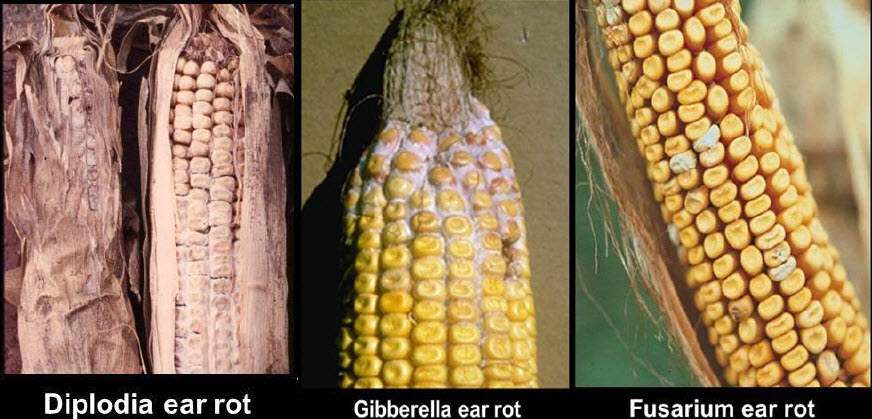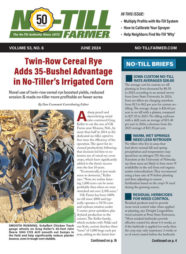By Pierce Paul
Ear rots or molds are usually most problematic when cool, wet conditions occur during silking and early grain development, when the ears are most susceptible to fungal infection. Three main types of ear rot (Diplodia, Gibberella, and Fusarium) usually affect corn in Ohio, and these differ from each other in terms of the damage they cause (their symptoms), the toxins they produce, and the specific conditions under which they develop. A good way to determine whether we will have an ear rot problem this year is to know how they develop and under what type of weather conditions. And the best way to tell the difference among the ear rots is to know the types of symptoms they produce.

Diplodia Ear Rot
Wet weather from mid-June through mid-July initiates the development of spores, and heavy rain showers just prior to tasseling deliver the spores to the susceptible parts of the plants. Continuous rain in July favors infection and disease development. Diplodia causes a thick white mass of mold to grow on the ear, usually initiating from the base of the ear and growing toward the ear tip. Eventually the white mold changes to a grayish-brown growth and infected kernels appear glued to the husk. Infected ears are usually lightweight and of poor nutritional value. When infections occur early, the entire ear may become moldy. When infections occur late, only a fine web of fungal growth appears on the kernels.
Gibberella Ear Rot
Like Diplodia ear rot, Gibberella ear rot is generally most severe when rain and wet weather occur during the 7 to 10 days after silking. The fungus enters the ear tips through the silk channel. Optimum temperatures for disease development are 65-70 F. Ears with visible white to pink mold covering the ear tip or more of the ears are characteristic symptoms of Gibberella ear rot.
Fusarium Ear Rot
Fusarium ear rot is especially common in fields with bird or insect damage to the ears. Affected ears usually have infected kernels scattered over the ear among healthy-looking kernels or are confined to kernels that are damaged. The fungus appears as a white mold and infected kernels sometimes develop a brown discoloration with light colored streaks.
With ear rot comes the additional concern of mycotoxin contamination. In addition to the physical damage caused by ear rots, some ear rot fungi produce mycotoxins that reduce the quality and value of the grain. There have been no reports of Diplodia producing mycotoxins under field conditions, however, Gibberella and Fusarium species are known toxin producers. Gibberella zeae (which causes Gibberella ear rot and stalk rot of corn and wheat scab) produces several different mycotoxins that are harmful to livestock. Vomitoxin is one of the most common mycotoxins found in Gibberella-infected kernels. Hogs are particularly sensitive to this toxin. Vomitoxin can cause feed refusal at concentrations in grain at around 1 ppm. Several different Fusarium species are involved with Fusarium ear rot. One common species produces a toxin called Fumonisin. Horses are particularly sensitive to Fumonisin, but cattle and sheep are relatively insensitive.
These are the risk factors for ear rots:
1. If your hybrid is susceptible to one or more ear rots, you may be at risk,
2. If weather conditions were (are) cool and wet (due to high humidity, dew, and rainfall) for an extended number of days (7-14) after pollination and in to early grain development, then you may be at risk.
3. If you are planting corn after corn, then you may also be at risk.
4. You are at the greatest risk for ear rots and the toxins they produce if all three of the above conditions are satisfied: hybrid is susceptible, weather after pollination was cool and wet, and you are planting no-till corn-on-corn.






Post a comment
Report Abusive Comment